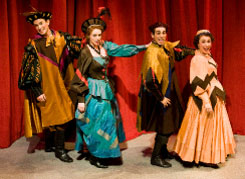Connecting the Dots
Peter Levine leads an effort at Tisch College to create a new role for social networking: linking community organizers around specific issues
By Helene Ragovin
In his popular social science book The Tipping Point, author Malcolm Gladwell explains the success of Paul Revere’s famous ride as an example of the power of social networks. Revere, an extremely outgoing and well-connected fellow, was able to rouse the patriots to action because so many people knew him—or knew of him—and thus responded to his call.

“Any community organizer has always had a mental network map. We’re just making it visible, which is democratizing,” says Peter Levine. Photo: Joanie Tobin
Indeed, social networks have functioned in one way or another for millennia—facilitating trade, spreading religious movements, fomenting revolutions. And with the arrival of the digital age, social networking has taken on another dimension. Knowledge of networks that once existed only in people’s minds can now be mapped and easily shared—witness the popularity of sites such as Facebook, MySpace or LinkedIn.
Now, a project under way at the Tisch College of Citizenship and Public Service seeks to use the tools of online social networking to help community organizers in the Boston area. The goal is to create a social networking application that will allow people at nonprofits and social action organizations to find each other, collaborate, share resources and work cooperatively toward common goals.
“Any community organizer has always had a mental network map,” says Peter Levine, director of Tisch College’s Center for Information and Research on Civic Learning and Engagement (CIRCLE). “We’re just making it visible, which is democratizing.”
The project is funded by a three-year grant from the Corporation for National and Community Service (CNCS). This semester, Levine is teaching a course through the Tufts Experimental College called “Facebook, Social Networking and Community Organizing,” in which students are gathering information and working on the software that will drive this new networking effort.
While there are plenty of networking sites geared toward personal, professional and commercial interaction, the existing framework doesn’t quite work for community organizing—hence, the need for this new effort, Levine says.
“Facebook is powerful for certain purposes, but it has some limitations for organizing civic activity,” he says. “You can only see the network from your own personal page, so you cannot tell who is central, who is left out, who should be working together and where organizing would bring the most potential benefit.”
Navigating the Network
The website under development for the Tisch project will link to social network sites like Facebook, MySpace or Twitter, while functioning as its own entity, Levine says. “We’re taking advantage of the fact that people like Facebook,” he says. “The trick is not to create some new civic network that no one is going to bother spending time on. For one thing, it will not just focus on people, but on organizations and issues. And you’ll be able to see the whole network publicly and navigate your way around it.”
For a visual example of what this sort of network might look like, Levine points to the News Dots feature on Slate.com, which offers a visual guide of the connections between the day’s top news stories.
To begin the project, students in Levine’s class are researching civic organizations in Somerville, before reaching out to the rest of the Boston area. The students come from a broad range of backgrounds—some with technical skills, others with none. Many are from the Communications and Media Studies program, with which the course is co-listed.
The data gathered for the networking website will also be used as part of a separate Tisch project, also funded from the CNCS, called Project PERIS, which seeks to assist Somerville in responding to the economic crisis.
Levine acknowledges that even when the networking application is completed, there will still be gaps—for instance, among community organizers who don’t have easy access to computers, or those who are not fluent in English. “Those are important issues,” he says. “I think to some extent you can solve them with service, if you’re very ethical and sensitive about that—because our students can help improve the level of representation.”
Tufts will also be working with other area colleges on this project—its first partners will be UMass-Boston and Suffolk University. “And we hope to keep reaching out,” Levine says.
Helene Ragovin can be reached at helene.ragovin@tufts.edu.

